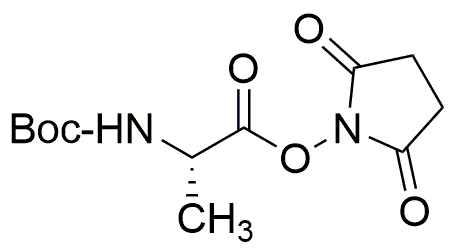Boc-L-alanine N-hydroxysuccinimide ester is widely utilized in research focused on:
- Peptide Synthesis: This compound serves as a valuable building block in the synthesis of peptides, enabling researchers to create specific sequences for studying protein functions and interactions.
- Drug Development: Its ability to form stable linkages makes it useful in the development of prodrugs, enhancing the bioavailability of therapeutic agents in pharmaceutical formulations.
- Bioconjugation: The compound is employed in bioconjugation techniques, allowing for the attachment of biomolecules to surfaces or other molecules, which is crucial in diagnostics and targeted drug delivery systems.
- Research in Neuroscience: It is used in the synthesis of neurotransmitter analogs, facilitating studies on synaptic transmission and neuropharmacology, thus aiding in the understanding of neurological disorders.
- Protein Labeling: This ester is also applied in labeling proteins with fluorescent tags, which is essential for visualizing protein interactions and dynamics in live cells.
Informations générales
Propriétés
Sécurité et réglementation
Applications
Boc-L-alanine N-hydroxysuccinimide ester is widely utilized in research focused on:
- Peptide Synthesis: This compound serves as a valuable building block in the synthesis of peptides, enabling researchers to create specific sequences for studying protein functions and interactions.
- Drug Development: Its ability to form stable linkages makes it useful in the development of prodrugs, enhancing the bioavailability of therapeutic agents in pharmaceutical formulations.
- Bioconjugation: The compound is employed in bioconjugation techniques, allowing for the attachment of biomolecules to surfaces or other molecules, which is crucial in diagnostics and targeted drug delivery systems.
- Research in Neuroscience: It is used in the synthesis of neurotransmitter analogs, facilitating studies on synaptic transmission and neuropharmacology, thus aiding in the understanding of neurological disorders.
- Protein Labeling: This ester is also applied in labeling proteins with fluorescent tags, which is essential for visualizing protein interactions and dynamics in live cells.
Documents
Fiches de données de sécurité (FDS)
La FDS fournit des informations de sécurité complètes sur la manipulation, le stockage et l’élimination du produit.
Spécifications du produit (PS)
Le PS fournit une description complète des propriétés du produit, notamment sa composition chimique, son état physique, sa pureté et les exigences de stockage. Il détaille également les plages de qualité acceptables et les applications prévues du produit.
Certificats d'analyse (COA)
Recherchez des certificats d'analyse (COA) en saisissant le numéro de lot du produit. Les numéros de lot et de lot se trouvent sur l'étiquette d'un produit, après les mots « Lot » ou « Lot de fabrication ».
Numéro de catalogue
Numéro de lot/série
Certificats d'origine (COO)
Ce certificat d'exploitation confirme le pays dans lequel le produit a été fabriqué, et détaille également les matériaux et composants utilisés et s'il est issu de sources naturelles, synthétiques ou autres sources spécifiques. Ce certificat peut être requis pour les douanes, le commerce et la conformité réglementaire.
Numéro de catalogue
Numéro de lot/série
Fiches de données de sécurité (FDS)
La FDS fournit des informations de sécurité complètes sur la manipulation, le stockage et l’élimination du produit.
DownloadSpécifications du produit (PS)
Le PS fournit une description complète des propriétés du produit, notamment sa composition chimique, son état physique, sa pureté et les exigences de stockage. Il détaille également les plages de qualité acceptables et les applications prévues du produit.
DownloadCertificats d'analyse (COA)
Recherchez des certificats d'analyse (COA) en saisissant le numéro de lot du produit. Les numéros de lot et de lot se trouvent sur l'étiquette d'un produit, après les mots « Lot » ou « Lot de fabrication ».
Numéro de catalogue
Numéro de lot/série
Certificats d'origine (COO)
Ce certificat d'exploitation confirme le pays dans lequel le produit a été fabriqué, et détaille également les matériaux et composants utilisés et s'il est issu de sources naturelles, synthétiques ou autres sources spécifiques. Ce certificat peut être requis pour les douanes, le commerce et la conformité réglementaire.


